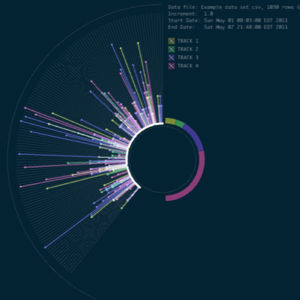Read more info below or just download the E-Rhythms Data Sonifier.
Download for Mac [Requires Mac OS 10.7.3] | Download for Windows
About the E-Rhythms Data Sonifier
The E-Rhythms Data Sonifier software allows you to listen to the rhythms contained within any time-stamped data.
How does it work?
The Data Sonifier works by counting the number of events that take place in a given period, and playing a sound to represent this number. You can choose the length of the period, which events to count, and how sound output should reflect this number (i.e., by adjusting pitch and/or volume).
For example, if you choose one day (24 hours) as your sample period, you will hear one beat for every day. One a day with a large number of events, then sound will be more intense, and on with fewer events, it will be less intense (or even silent). You’ll be able to hear rhythmic patterns on a daily schedule, such as whether activity is different on weekends or other days. Choosing a shorter sample period, such as one hour or fifteen minutes would allow one to identify rhythms on a finer scale (whether activity change around lunch time, in the evenings and so on).
You can create rules that direct certain types of events to four distinct tracks. This allows you to compare rhythmic differences between these types of events. These rules are built according to whatever is already in your data, so no special formatting is required.
Why Not Just Visualize Your Data?
Sound and images are processed differently and may bring to our attention different aspects of the same data. Given that data exploration is subjective in nature, this sonifier was developed to provide another tool that might help researchers recognize patterns that may be less easily recognized when visualized.
Doesn’t Sonification Software Already Exist?
It does. However, we were unable to find software that focuses mainly on the rhythmic aspects of data. We feel that rhythmic sonification is particularly well suited to understanding interactional data that occurs in short busts over time (e.g. mobile texting data). Moreover, we wanted to develop software that was simple to use for social scientists who might be unfamiliar with advanced aspects of sonification, but still want to explore their data using a sonification approach.
Using your data
In order to use your data with the Data Sonifier, all you have to do is save it as a .csv file. One column of the data must contain a time-stamp, and the data in the other columns can be used for setting up filtering rules.
Formatting for the time stamp column must be consistent across all rows, and should follow one of the following structures:
YYYY-MM-DD HH:MM:SS
YYYY/MM/DD HH:MM:SS
YYYY-MM-DD HH:MM
YYYY/MM/DD HH:MM
An example data file is included with the software so you can test it out before converting your data (‘Example data set.csv’ in the ‘example data’ folder).
Detailed instructions are in the ‘ReadMe.docx’ file included with the software.
Software Download
Download for Mac [Requires Mac OS 10.7.3] | Download for Windows
The software currently requires Mac OS 10.7.3 or newer, but a Windows version is in the works. You will need to set your Mac to allow the use of apps downloaded from “anywhere” (System Preferences -> Security & Privacy -> General).
E-Rhythms Project Information
see: http://individual.utoronto.ca/jboase/e-rhythms.html
The Data Sonifier is part of the E-Rhythms research project directed by Jeffrey Boase. Software development is led by Jack Jamieson. Visualization is designed and coded by Hirokazu Oda.
Development of the E-Rhythms Data Analysis Software is supported through a grant from the Social Sciences and Humanities Research Council of Canada.
